IO AR T Q UILT ASSOCIATES

2022 | Volume 32, No. 4 JOURNAL
INSIDE: MEET PATTI PASTEUR • SET UP A PHOTO STUDIO • PRESENTATION TIPS FROM A FRAMING PRO • FUNNY • LEARN ABOUT NFTs • MANAGE YOUR TIME • INSPIRED: ANN HOULE • JURIED ARTIST SHOWCASE • EBB & FLOW
STUD
. . . . . . . . . . . . . . . . . . . . . . . . 3
Thoughts from the president . . . . . . . . . . . . . . . . . . . . . . . . . . . . . 5
Inspired: Ann Houle . . . . . . . . . . . . . . . . . . . . . . . . . . . . . . . . . . . . .38
GALLERIES: Member Gallery: Funny . . . . . . . . . . . . . . . . . . . . . . . . . . . . . . . . . . 6
SAQA Global Exhibitions: Ebb & Flow . . . . . . . . . . . . . . . . . . . . 12
Juried Artist Showcase . . . . . . . . . . . . . . . . . . . . . . . . . . . . . . . . . 22
SAQA NEWS
In Memoriam: Rhonda Baldwin and Judy B . Dales . . . . . . . . . . 35
BOARD MEMBERS
PRESIDENT Mel Beach San José, California
VICE PRESIDENTS
Shannon Conley Moore, Oklahoma
Dolores Miller San José, California
TREASURER
Gwyned Trefethen Cohasset, Massachusetts
Lilo Bowman Fort Worth, Texas
Holly Brackmann Ukiah, California
Earamichia Brown McKinney, Texas
Jette Clover Lier, Belgium
Vivika DeNegre Guilford, Connecticut
Carolyn Ducey Lincoln, Nebraska
Cynthia Friedman Merion Station, Pennsylvania
Jaimianne Jacobin Silver Spring, Maryland
Kathie Kerler Portland, Oregon
ON THE COVER: Ann Houle
Puck Drop 32.5 x 42.5 inches (83 x 108 cm) | 2021
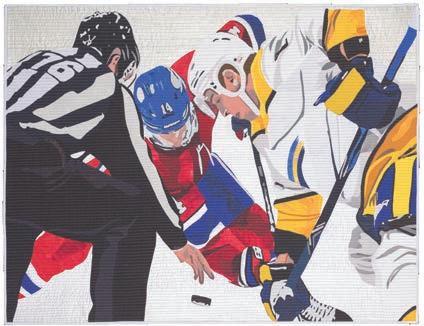
Photo by David Reese
QUICK NOTES
To find out more about SAQA, contact Martha Sielman, executive director, by phone at 860.530.1551, or by email at execdirector@saqa.com.
Explore varied resources on our website at www.saqa.com. Annual membership levels for U.S. and international members, listed in USD, are: Artist/Associate, $80, and Juried Artist, $145. Prices will increase in 2023.
Studio Art Quilt Associates, Inc. (SAQA) is a nonprofit organization whose mission is to promote the art quilt. Through exhibitions, resources, publications, and membership, we seek to increase appreciation for the art quilt as a fine art medium and to support our members in their artistic and professional growth.
The SAQA Journal is published four times a year. To submit articles or story ideas, contact Diane Howell, SAQA Journal editor, at editor@saqa.com. Review submission guidelines at www.saqa.com/journal-submit For delivery questions, contact circulation@saqa.com. For advertising information, visit www.saqa.com/ads
Claire Passmore Riviere du Rempart, Mauritius
Candice Phelan Boynton Beach, Florida
Sara Trail Antioch, California
Maggie Vanderweit Fergus, Ontario, Canada
EXECUTIVE DIRECTOR
Martha Sielman Hebron, Connecticut
2 • SAQA Journal • 2022 | No. 4
SAQA
EDITOR
YellowDog
Go Green! You can choose to read the SAQA Journal online only. Log in to mySAQA (www.
and select Manage Your Account. IN THIS ISSUE FEATURE ARTICLES: Presentation tips from a framing pro . . . . . . . . . . . . . . . . . . . . . . 8 Set up a high-quality photo studio . . . . . . . . . . . . . . . . . . . . . . . 14 Featured Artist: Patti
All about NFTs: Should you dive in?
It’s about time—manage yours wisely
JOURNAL
Diane Howell Chandler, Arizona DESIGNER
Denver, Colorado
saqa.com/mySAQA)
Pasteur . . . . . . . . . . . . . . . . . . . . . . . . . . . 18
. . . . . . . . . . . . . . . . . . . . . . 26
. . . . . . . . . . . . . . . . . . . . 29 COLUMNS: Editor’s Notes . . . . . . . . . . . . . . . . . . . .
How important are firstworld problems?
by Diane Howell
A host of first-world problems beset me. The laptop I love is breaking. It will have to be replaced after this issue. The email service I love changed its format and, for no apparent reason, has begun to block file downloads. I have to change to another service. The neighbor’s key to open the door to get into the house to feed the cats is wonky. It was so hard to work that I hoped that I had broken it so that they would have to replace it. I am per haps too good at finagling locks.
Bottom line: I have to face that there is a long list of things that aren’t perfect and accept that many are out of my control.
The real bottom line: Who cares? News of one disaster after another arrives with every update of my newsfeed. War in Ukraine. A volca nic explosion in Italy. North Korean missiles shot over Japan. Unrest in Iran. More and more school shootings in the United States. It is never-ending doom. What then, do any of my first-world problems
matter? They don’t, in no small part because they are quickly fixed with first-world solutions. The laptop? Research and a credit card end that problem. Email service? Use one of the other email services and move on. The lock? Well, there’s still nothing I can do about that. But, hey, the cats ate and the door locked behind me.
The world around me continues in chaos, and the most that I can say about that is that I recognize the mayhem. I frequently feel over whelmed, and am amazed that I find my uneasiness begets gratitude. It makes realize the sweetness of having tools in the kitchen—of hav ing a kitchen! I know that my new little dog—who arrived here after my friend, Ted, died in his sleep on Easter Sunday—is safe. I have a new outlook on what is important. The lingering heat in Arizona is noth ing compared to the destruction from Hurricane Ian in Cuba and Florida. The need to drive a relative back and forth to work is nothing
compared to the horror taking place in countries engaged in war. The ability to carry on is what’s impor tant. My road is easy. I’ve no reason to whine.

These musings also make me realize how thankful I am for the writers who contributed to this issue. They are individuals focused on moving forward and making a difference in the world. Please enjoy their articles; they were written with purpose. The edito rial lineup includes: Susan Lenz, who offers tips on how to present your art for sale on page 8; Kestrel Michaud, who tells you how to set up a professional-style photo studio on page 14; Alexander Taylor, who tells us all about the world of NFTs on page 26; and Clara Nartey who offers a primer on time manage ment on page 29. You’ll also meet featured artist Patti Pasteur on page 18 and Inspired artist Ann Houle on page 38. Along the way, our gallery departments will inspire you.
Thank you for reading! ■
SAQA Journal • 2022 | No. 4 • 3
EDITOR’S NOTES
4 • SAQA Journal • 2022 | No. 4 Registration is open! For more details, visit www.saqa.com/conference SAQA’s 2023 Annual Conference Pathways to Possibilities Toronto Hilton In the heart of the city Keynote Speakers: Dorothy Caldwell and Chunghie Lee Participate in the 2023 online Spotlight Auction Details at www.saqa.com/spotlight 2024 Annual Conference A virtual event featuring our Europe & Middle East Region
SAQA is here to help you meet your 2023 artistic resolutions
by Mel Beach
The start of a new year is the perfect opportunity to set new artistic and/ or professional resolutions. Luckily your SAQA membership includes access to a wealth of programs and resources to support your artis tic goals. In fact, the amount of information available with your SAQA membership can be a little overwhelming, so I thought I would offer a few suggestions to help chart your personalized artistic/profes sional development path:
• Explore new materials and techniques: The 2023 SAQA Seminar will focus on materials, so get ready to discover new materials to incorporate into your fiber art. Consider joining a Special Inter est Group, such as Cutting Edge to learning about digital cutting machines; Art Quilt Design on a Mid/Longarm Machine; or the 100 Days Project to be inspired to cre ate on a daily basis.
• Learn to critique your own work: Attend or watch any of the recorded critique series to learn how to effectively evaluate your own work. Most include a critique guide that can be downloaded to use as a resource when critiquing

your own work. Or you can join the SAQA-Artique Facebook group to give and receive honest feedback on projects.
• Exhibit your art: Check out SAQA Calls for Entry for an upto-date list of global exhibitions, virtual gallery calls, regional exhi bitions, and other opportunities to exhibit your artwork. Maximize your chances of being juried into these fiber art exhibitions by utiliz ing articles and resources available on the website that address taking high quality photographs and writ ing your artist statement.
• Market and sell your art: There are a ton of articles and vid eos posted on the SAQA website, packed with advice about how to market, price, monetize, and sell your art. On Facebook, check out the Professional Online Presence Special Interest Group for more resources and tips to promote your art online through your website and/or social media channels.
• Take your art to the next level by applying for the Juried Art ist Program and/or Mentorship Programs: Both programs offer
additional layers of support for fiber artists to get your art out into the world!
• Network with fellow members: Regional events and local connec tion groups are a wonderful oppor tunity to connect with members in your area. As a global organization, there are plenty of opportunities to connect with the more than 4,000 SAQA members living all around the world! There promises to be lots of in-person networking in Toronto during the Annual Conference, with a virtual mini conference to be held later in the year. Join me for a monthly Live Chat to connect with other members via breakout rooms. Forge new conversations via the SAQA-Members Only Facebook group. Last but not least, volunteer within your region or serve on a committee, as these are fabulous opportunities to meet fellow mem bers while helping SAQA meet our mission to promote the art quilt. As you can see, your SAQA mem bership provides exceptional value and support to achieve your creative endeavors. I wish you great success in achieving your goals during the upcoming year and beyond! ■
SAQA Journal • 2022 | No. 4 • 5
THOUGHTS FROM THE PRESIDENT
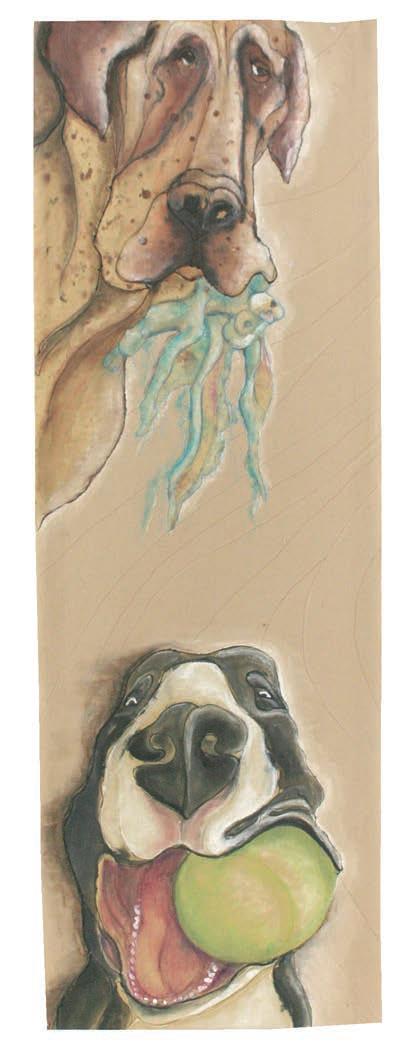


6 • SAQA Journal • 2022 | No. 4
MEMBER GALLERY
Funny
x 24 inches (183 x 61 cm) | 2022
Holly Cole Dogtoys 72
|
Sharon Emerson Jay Walking 19 x 31 inches (48 x 79 cm)
2021
17
(43 x 51 cm) | 2019
Joanna Mack Oops!
x 20 inches
Zara Zannettino


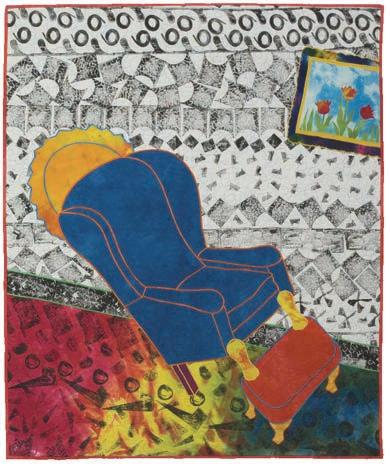

SAQA Journal • 2022 | No. 4 • 7
10
Lana Dragon I'm either Sewing or Mowing unless it's Snowing
x 7 inches (25 x 18 cm) | 2021
Nude
Reclining 50
42 inches (127
107
|
Laura Wasilowski
Blue Chair
x
x
cm)
1996
34
Candace Hackett Shively
Zoomsick
x 55 inches (86 x 140 cm) | 2021
Photo by David W. Shively
Absurd
60
21 inches
| 2021
Birds
x
(152 x 53 cm)
Presentation pointers from a professional picture framer
by Susan Lenz
A four-inch sleeve might be the easi est and best way to present a large art quilt, but this approach is often problematic for smaller pieces or to expand into other avenues to show and sell our work.
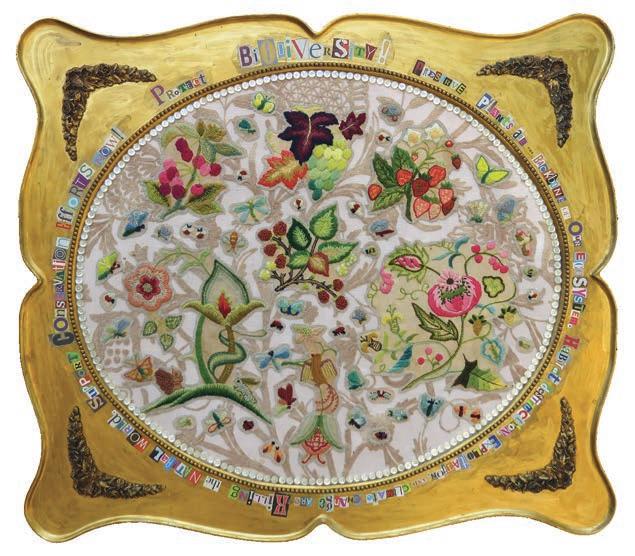

Fortunately, there are other options, some of which directly relate to the framing industry. I have been a certified professional custom picture framer since 1988, and can share methods that don’t cost a small for tune or require fancy equipment. I’m talking about ways to package, mount, and display art quilts that gallerists and the general public understand.
One of the best methods is to pres ent our art in a transparent, protective bag with resealable, adhesive strips on the closing flap, such as those used for paintings and prints. They can be mat ted or simply mounted to a backing board. On the backside, there is often an artist’s business card or printed paper with the artist statement, bio, and contact information. This pack aging style is very professional and also very affordable. An art quilt can be presented in the same way. Using a chenille needle and buttonhole thread, just four tiny stitches— one per corner—mounts a small art quilt to the center of a backing board. Once slid into the bag and sealed, it is easy to attach a price tag and place it into a bin with other two-dimensional art work. This is just the sort of presenta tion that gallerists understand, even those who haven’t yet warmed to fiber arts. This setup also allows quilt artists to participate in arts festivals even if they do not have walls for a booth. In addition, lots of nonprofit organiza tions have approached me for auction
8 • SAQA Journal • 2022 | No. 4
Biodiversity 37.5 x 42.5 inches (95 x 108 cm) | 2020
Susan Lenz collages words onto a frame to hold Biodiversity.
donations. In these protective bags, my donations are easy to showcase at these events.
The art quilt doesn’t have to have finished edges. It can be mounted behind a mat board with a precut opening. There are plenty of online businesses that sell standard paper and conservation-grade mats in a variety of sizes. I am particularly fond of Clear Bags, a thirty-year-old company with warehouses in Las Vegas, Nevada, and Selmar, Tennessee. They have global partners in Ontario, Canada, and Sassenheim, Netherlands. Every time I’ve dialed their toll-free number, I’ve talked to a real person who knows the product line or immediately transfers me to someone who does. Not only does this company sell mat boards
(with and without a precut opening), backing boards, and foam-centered boards, it markets Crystal Clear bags with resealable adhesive strips on their flaps. Their selection of bags come in a variety of sizes to accommodate thicker artwork. They also sell blank greeting cards.
When the pandemic hit, I faced my own, overly full print bin. There were so many artworks crammed into the limited space that browsing through the selection wasn’t possible.
So, I started cutting up older pieces into one-of-a-kind greeting cards. Each one was put into a Crystal Clear bag with a matching envelope. This allowed me to participate in local sidewalk sales and have small, afford able work in gift shops that would
not otherwise be interested in stock ing my larger art quilts.
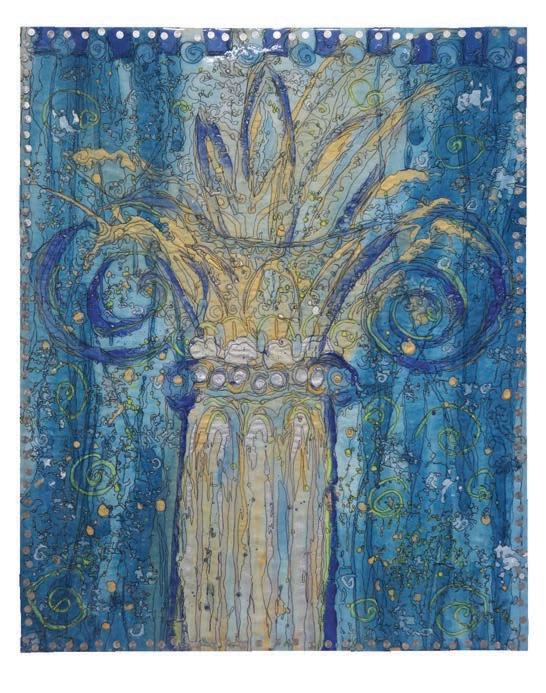

Cutting up my older work was a scary ordeal. However, I quickly found small areas of each piece that could

SAQA Journal • 2022 | No. 4 • 9
Capital on Gold 32 x 26 inches (81 x 66 cm) | 2020 Capital on Blue 32 x 26 inches (81 x 66 cm) | 2020
A hammer and tacks can be valuable mounting tools.
stand alone. Some of these went under a precut mat and into a transparent bag. Some were literally nailed to a stretcher bar over which I glued a piece of acid-free mat board. I first painted the edges of the stretcher bar for a finished look. This approach gives the work a unique look without the need of binding. Occasionally, I’ve flooded the soft surface with Golden’s GAC 400, a fabric stiffener with a transparent finish, and then poured UV filtering epoxy over the whole. Capital on Gold was designed and nailed this way. Sleeping Beauty was once much larger; I cut it down and glued it to sanded pieces of wood.
I am particularly fond of decora tive tacks, especially those ordered in boxes of 250 pieces from Lee’s Decorative Showcase, an upholstery supplier. My test piece for Saint Anastasia , currently part of the SAQA’s 3D Expression ’s global exhi bition, was tacked to the front of an old, flat-top frame.
Using frames purchased at thrift stores and yard sales is also a way to present an art quilt without pay ing retail prices for custom picture framing. If the frame isn’t in perfect shape, distress it with sandpaper and a variety of tools. Embellish it with tacks or paint it with a stain blocker like Zinseer’s B-I-N Primer and then any color paint desired. (Note: painting a frame with acrylics is to be avoided. Most moulding is var nished; acrylics peel off in just a short amount of time. Zinseer products are available at most hardware stores.)

Biodiversity was intentionally designed for a large, ready-made frame I bought at a local auction house.
Generally, as a professional framer, I don’t purchase used frames, but I have repurposed many ornate mirror frames from my own shop.

10 • SAQA Journal • 2022 | No. 4
Sacred
Framed size: 27.5 x 23.5 inches (70 x 60 cm) | 2018
Heart Madonna
Small areas of older art quilts can be repurposed as greeting cards.
Mid-century modern aesthetics have rendered these frilly frames mostly obsolete, but they have proved quite useful for pieces like Sacred Heart Madonna (page 10). The piece fea tures one of my own digital images printed on fabric and embellished with embroidery, trapunto, and freemotion machine quilting. The art work was designed to fit the frame. The edges were pinned around acidfree, foam-centered board.

Floater frames are another way to finish art quilts that have been stitched to stretched canvases. They provide the transition from the art work to a client’s room décor when everything else in the setting has a traditional frame. Floater frames are designed to fit stretched canvases and come in a variety of sizes. They are available from several online shops.
While not every professional framer is willing to share their knowledge, many are. Many are only too happy to cut their scrap mat board into standard sizes at affordable rates. For those quilt art ists with a retail sales tax number, visiting a framing distributor is an option. Distributors are limited to wholesale clients, but a tax num ber qualifies an artist to set up an account with wholesale pricing.
There are all sorts of other pre sentation options available to quilt artists—just think “inside the box.” The frame can be the box that opens a gallery’s door and allows an art quilt to be submitted to a juried show requiring a wire for hanging. Remember, artists working in other media have had to figure these things out. So can you! ■
Susan Lenz is a SAQA Juried Artist who resides in Columbia, South Carolina. You can view her work at www.susanlenz.com.

SAQA Journal • 2022 | No. 4 • 11
Sleeping Beauty
14 x 13.5 inches (36 x 34 cm) | 2019
A test piece for Saint Anastasia was tacked into an old flattop frame. This piece from 2018 measured 15 x 12 inches (38 x 30 cm).
Selections from
Many aspects of life demonstrate recurring patterns of growth and decline. Dynamic movements are everpresent, from the phases of our own lives to the tides. Change is constant, and this exhibition explores how its energy flows freely through time.

The curator for Ebb & Flow is Linda Colsh, an artist who examines humanist themes in her work as well as connections between natural spaces and populated, constructed places. Colsh’s imagery and minimal palette is known worldwide, and her artwork is in collections in Europe, Asia, and the United States. She is a recipient of the European Quilt Triennial first prize and Nihon Vogue’s Quilts Japan Prize.
Exhibition benefactor is Frank Klein.
For more details, including all exhibition artwork, videos, and schedule, visit www.saqa.com/ebbandflow.

Manley

12 • SAQA Journal • 2022 | No. 4
42.5 x 40.5 inches (108 x 103 cm) | 2019
Jackie
Homage to Piet (Mondrian)
Merge 34 x 33 inches (86 x 84 cm) | 2020
Photo by Cleary Creative Photography
K. Velis Turan
Photo by Bob Turan Attitude Adjustment 52 x 52 inches (132 x 132 cm) | 2016
Mandy
Miller
Photo by Jon Christopher Meyer




SAQA Journal • 2022 | No. 4 • 13
Timing is Everything 30 x 40 inches (76 x 102 cm) | 2019 Fabia Delise Route 112 NH 49 x 49 inches (124 x 124 cm) | 2020
Ginny McVickar
Journey in Solitude 43 x 51 inches (109 x 130 cm) | 2019
Cynthia D. Friedman
Seaweed 42 x 36 inches (107 x 91 cm) | 2018
Photo by John Woodin
Dianne Firth
Photo by Andrew Sikorski
You can build a pro photo studio on a budget— here’s how
by Kestrel Michaud
A photographic to-do list may seem daunting, but adherence to a stan dard set of criteria is key to taking great photos of art quilts. Whether the images are for a call for entry or for print reproduction, they should include these factors:

• Clean, neutral background behind quilt
• Even lighting
• Visible quilt edges
• Artwork squared and in focus
• Color in photo matched to origi nal art
• Data-size requirements met for a given call or publication
Most of the items on this checklist can be achieved by having a profes sional photo studio setup in your home or quilt studio. While that sounds expensive, it can be done on a budget. My studio, for example, is set up my garage and was done at minimal expense. It allows me to take high-resolution photos for a variety of purposes. The two studio setups discussed in this article will address the first four topics on the checklist; two criteria—color matching and image sizing—will be covered in a follow-up article.
Studio 1
This option for a home photo studio is for those who plan to shoot a hanging quilt. In this setup, the quilt
should be hanging vertically and the camera should be centered and facing the quilt. Imagine holding a camera in your hand to take a photo of a quilt hanging on a wall.
To start, find a neutral wall. Neutral means solid, no patterns, and prefer ably white or black, but beige or grey is also acceptable. The background should not be distracting in any way. Quilts with dark bindings or edges should not be shot on black, as it makes it hard to distinguish the actual edges of the quilt.
A design wall—provided the design wall has nothing else on it—could
be an easy option. If the design wall is already occupied, either move the work-in-progress project or cover it with a plain bedsheet. If a design wall, or other plain wall, isn’t an option, drape a plain bedsheet over a backdrop stand (see Figure 1). Backdrop stands are used by pho tographers to support a background behind a subject. They look like a horizontal bar supported by two tripods. Backdrop stands are inexpen sive and can be purchased online. Suspend a bedsheet over the bar or purchase an actual photo backdrop drape to use.
14 • SAQA Journal • 2022 | No. 4
This photo of my art quilt Beauty Queen meets all of the criteria listed for a professional photograph. This is the image I used to submit to SAQA’s Fur, Fangs, Feathers & Fins call for entry. The piece was juried into the exhibition and is now on tour with it.
Figure
1
This is an example of a quilt hanging against a sheet draped over a backdrop stand. The S-hook is black and the backdrop is tan in this illustration so that readers can easily see them. In reality, they should both be white to allow this quilt to stand out. If your quilt is white or light-colored, a black backdrop and black S-hook may be a better choice than white.
The next step is to hang the quilt. The easiest, most versatile method I’ve found to hang my quilts is to add a centered hole in a standard 4-inch hanging sleeve. This allows my quilts to hang at SAQA shows, traditional quilt shows, in my home, or in a gal lery on one nail or pushpin.
If using a wall, hang your quilt in whatever fashion you normally use, with one exception. Do not push pins through the front of the quilt to attach it to the wall. These pins, even tiny dressmaker pins, will show up on the photograph. If using a backdrop stand, you can use fishing line to hang the quilt from its slat or use an S-hook (See Fig ure 1). Either method will support your quilt lower than the top of the backdrop so that it’s surrounded on all sides by the neutral background. If using a modified hanging sleeve, only one S-hook may be needed as the quilt will be suspended from the center. Otherwise, two S-hooks may be needed to support the quilt on the left and right sides. (Note: S-hooks are available in black and white. If using a light backdrop, use a white hook. If using a dark back drop, use a black hook.)
Even lighting is important to show off your quilt without distract ing shadows. The goal is to have an equal amount of light hitting all areas of the quilt. The best way to achieve even coverage of uniform
light is to use a “softbox lighting kit”. (See Figure 2). Lighting kits are inexpensive and come with two softboxes, which are professional photographic lighting devices that diffuse bright light over a large area. Position one softbox on either side of the quilt and adjust the height of each so that the centers of the softboxes are roughly center with the quilt.
It’s also important to pay atten tion to the color of light. Ideally, use bulbs that are rated for 5000k, which is “daylight” or “natural” light. Daylight bulbs will not alter the colors of your quilt. Some softboxes use LED bulbs that have a range of color. If using that style of bulb, manually adjust the bulb to be as close to 5000k as possible.
A modified hanging sleeve allows for easy quilt hanging in a variety of settings. Illustrated instructions for this modified hanging sleeve are free and can be on my blog using the QR code found on page 17.
Figure 2
Two softboxes have been positioned on either side of the quilt. The boxes are aimed at the quilt and provide even lighting across the entire surface of the art.
Shopping List for Studio 1
(Prices are approximate and in USD)
• Photo backdrop stand: $40



• Softbox lighting kit (two softboxes, each 20 x 28 inches): $90
• Bedsheet: $15
• Set of S-hooks: $10
• Tripod: $35
•
Optional ball-head for tripod: $30
• Optional cell phone holder for tripod: $15
• Optional cell phone remote: $10
• Total: $190-$220, depending on optional accessories purchased
SAQA Journal • 2022 | No. 4 • 15
Studio 2
The second option for a home studio is for anyone who finds it easier to lay a quilt on a flat surface and shoot down on the quilt from above. Imag ine your quilt lying on the floor while you hold your camera over it to take the photo. This is the studio style I have in my garage.
Here again the first step is to find a neutral surface. One option is to lay a white or beige bedsheet on the floor. Another option for a more permanent studio setup is to make a rolling stage. I have a 36 x 48-inch wooden stage on
Shopping List for Studio 2
(Prices are approximate and in USD)
casters that provides a neutral back ground for my quilts and lets me move them under my ceiling-mounted cam era (more on that in a bit). Materials for my wooden stage cost about $80.
The next step is to place the quilt. Since the quilt doesn’t have to hang, this step is easy. Place your quilt on the neutral surface, positioned so that the surface is visible around all edges of your quilt. If you’re using a bedsheet, make sure at least a few inches of sheet are visible all the way around your quilt.
the softboxes on either side of your quilt and tilt their boxes downward. (See Figure 3.)
• Softbox lighting kit: $90 OR four 4-foot shop lights: $120
• White bedsheet: $15 OR wooden stage: $80
• Tripod and extension arm (and sandbag for counterbalance): $95 OR camera ceiling mount : $40
• Optional ball-head for tripod or ceiling mount: $30
• Optional cell phone holder for tripod or ceiling mount: $15
• Optional cell phone remote: $10
• Total: $200-$240, depending on optional accessories purchased
Naturally, you will once again need even lighting on your quilt as the goal is still to have an even amount of light on every part of the quilt. Softboxes are still a good option, pro vided they can be positioned to aim down at the quilt (most softboxes have a range of motion that allow their boxes to be adjusted). Position
For a more permanent solution— and the one I use myself—suspend shop lights from the ceiling. I have four, 4-foot LED shop lights sus pended from my garage ceiling. They provide even, consistent lighting across the entire wooden stage, even as the stage moves underneath. (See Figure 4.).And since they’re in my garage, the whole setup is hidden from visitors, I don’t lose any usable floorspace in my house, and it’s always available when I need it. All I have to do is move my car, which is usually parked underneath.
Once again, the color of light is very important. Purchase lights that are rated at 5000k.
Cameras
What you want to do with the quilt photo will determine what kind of camera you need. If you want to have a photo that can be submitted to a call for entry, using a smartphone camera is probably good enough, but only if your phone was released in the past couple of years. The photo requirements for
Figure 3
The quilt has been laid on a sheet on the floor. Two softboxes are positioned on either side of the quilt. The boxes are aimed down at the quilt to provide even lighting across the entire artwork.
Figure 4
The quilt is placed on a rolling wooden stage. Ceiling-mounted shop lights with ceiling camera mount in the center hang above. The camera is not shown in this illustration.


16 • SAQA Journal • 2022 | No. 4
calls for entry are typically low, as most websites do not allow users to upload large images. A photo taken by a smartphone—especially when the quilt is photographed in a studio setup like those described in this article—will be sufficient to capture a full-size quilt photo and detail photo for the purpose of entering a call for entry. A photo taken by a smartphone in any capacity is not suitable for any kind of largescale print reproduction. For that, a digital single-lens reflex (DSLR) camera is a requirement.
If you plan to make any sort of printed reproduction of your art— whether your quilt is going to appear in a magazine, on the cover of an exhibition catalog, in your shop on Spoonflower, or as a print reproduc tion on canvas—ideally you need a DSLR camera. DSLR cameras capture images at much higher resolution than the cameras in smartphones, meaning a DSLR’s photo can record intricate detail that other cameras will miss. This detail, such as indi vidual stitches or the texture of fabric, is critical to have for the entire quilt when making a print reproduction.
Taking the Photo
Regardless of what type of camera you’re using, the camera should be positioned so that all edges of the quilt are visible in the frame and “square.” This means that the edges of the quilt are parallel to the edges of the cam era’s visible area. In other words, all four corners of the quilt should be 90 degrees, i.e., square, in the camera’s viewfinder. If the camera is not cor rectly aligned to the quilt, warping or distortion could degrade the quality of photograph taken. (See Figure 5.).

Although hand-holding a smart phone or DSLR camera to photo graph your quilt is an option, it’s not recommended. Holding a camera in your hand, regardless of what type of camera you’re using, is going to make it difficult to square your quilt to the edges of the frame and may make your photo blurry because your hands provide unsteady support.

Instead, consider using a tripod with ball-head mount (for a DSLR camera) or tripod with cell phone mount (for a smartphone). A tripod will be a
see “Photo Studio” on page 34
Scan for Kestrel Michaud's hanging sleeve instructions or visit www.kestrelmichaud.com/blog/2021/ modified-hanging-sleeve/
Scan to read Kestrel Michaud's blog on the basics of copy photography, or visit www.kestrelmichaud.com/blog/2018/ basics-of-copy-photography/


Figure 5
Align the camera so that the quilt is “square,” All corners of the quilt should be 90-degree square angles, and the edges of the quilt should be parallel with the edges of the viewing frame.
SAQA Journal • 2022 | No. 4 • 17
These two detail shots of Beauty Queen show a quality comparison between cameras. The left image is a 5-inch crop from a photo of Beauty Queen taken by a DSLR Nikon D850 camera. The right image is a 5-inch crop from a photo of Beauty Queen taken by an iPhone 11 Pro Max.
Patti Pasteur
An artful way with nature
by Diane Howell
Nature is a force within Patti Pasteur’s thoughtful art quilts. The moon caught in tree branches recalls romance. Rolling hills engen der wanderlust. Strong colors evoke emotions.
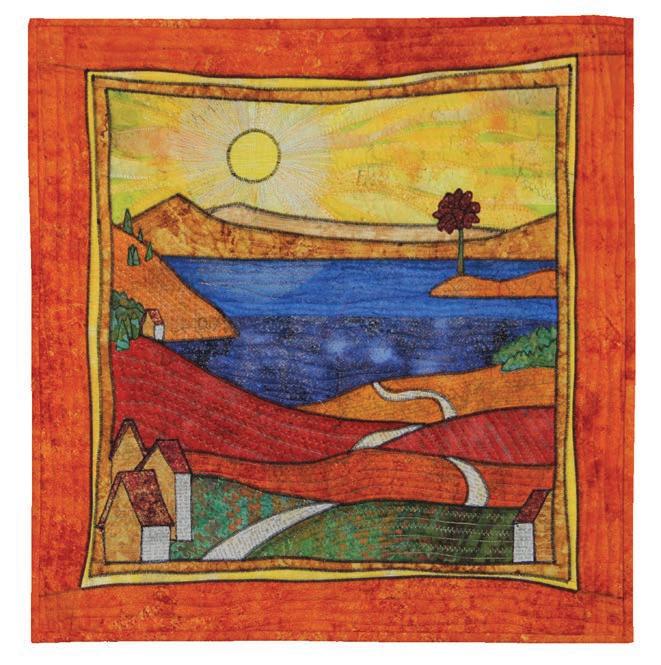
“I’m strongly influenced by the surroundings I happen to be living in at the time. While liv ing in New Hampshire, my house was surrounded by a state forest and ancient rock walls. The scene
outside my windows would change with the seasons and the weather. I would often hang out of my secondstory window and take photo graphs. In Maine, I was living on a lake and was again surrounded by woods. Now that I’m living in North Carolina, my subjects will be the coast and whatever place I happen to be visiting. I am drawn to photo graphing trees because of the light
and shadows peaking through the branches,” she says.
But art quilts aren’t where Pas teur started her creative journey. In the 1970s, she wove tapestries on a 45-inch floor loom, but the themes were familiar. “Those weavings were of trees—or the coastal shore while I was living in Florida. I started to make traditional quilts in the 1980s. I made a king-size Chevron quilt for the bed, and swore I would never

18 • SAQA Journal • 2022 | No. 4
FEATURED ARTIST
Patti Pasteur in her studio
20.5
20.5
Long Road Home
x
inches (53 x 53 cm) | 2019
make another quilt. It was years later that I discovered Quilting Arts Magazine and fireworks went off in my head with the possibilities of creating smaller and unique quilts.”
She started to dabble with handpainted fabric. “I wondered what would happen if I printed an image on top of the surface. I had no idea on how to use Photoshop until I sat down and started to play with the software. I have long admired Margaret Abramshe, Caryl Bryer Fallert-Gentry, Wen Redmond, and many others for what they can do with digital fiber art.”
Pasteur creates by combining a variety of techniques, including digital imagery, collage, stamping, dyeing and painting fabric, layer ing, plus machine and free-motion stitching. She has honed her skill with these techniques through years of play and trial and error. The result is a body of work that is a “combination of abstract and a little figurative art involving nature.”
One example of this comforting blend is her series with hills and abstract trees, Lake Series . It was inspired by a favorite painter, GC Myers from the Finger Lakes area in New York. “His paintings led very well to a quilt, and he graciously gave me permission to use his paint ings as inspiration.” One of the

12 x 12 inches (30 x 30 cm) | 2021

SAQA Journal • 2022 | No. 4 • 19
Winter Solstice
13 x 18.5 inches (33 x 47 cm) | 2021
Once in a Blue Moon
quilts inspired by Myers is Long Road Home (page 18).




Many of Pasteur’s other works are the result of hours spent with Pho toshop. In the computer program, she builds up layers from several photographs to create just the right final image. “The exciting part of doing this is that I never know what the end result will be when I start.”
Color is alive within Pasteur’s work, with serene or stark blues often playing a captivating role, as seen in Winter Solstice and Once in a Blue Moon (both pictured on page 19), two pieces in her New Hampshire Series . “Color plays a very important role in everything I do. When I do an outdoor art show, I place my colorful pieces up front to attract customers. Winter Solstice is based on a photograph taken in my New Hampshire backyard during a snowstorm. The original photo was just a boring fuzzy picture with trees and snow. When I combined the photo with several others, the result was dramatic. The image was
20 • SAQA Journal • 2022 | No. 4
Day’s End 22 x 19.5 inches (56 x 50 cm) | 2021 Sunrise After the Storm 39 x 34 inches (99 x 86 cm) | 2020 There Was One Left 28 x 27 inches (71 x 69 cm) | 2020
printed on cotton and machine and free-motion stitched. The trees in the foreground were collaged with bits and pieces of fabric. Once in a Blue Moon was part of the same series of photographs taken from my second-story window. When the light is hitting the trees in a certain way, I can’t resist opening up that window, even when it’s 10 degrees Fahrenheit outside, to get the shot. I was thrilled that it sold in SAQA’s 2021 Benefit Auction. Another piece, Soleil Levant , is part of that series as well. I’m thrilled it was accepted into the Virginia & North Carolina regional exhibition Let the Sunshine In! ”
In summer 2022, Pasteur’s piece, Sunrise After the Storm , was juried into the 2022 Bank of the Arts National Juried Exhibition, a bien nial exhibition in New Bern. This is the first year quilts were accepted, and her piece won the Craven Arts Council & Gallery Perma nent Collection Purchase Award. It will be exhibited in various

public buildings throughout North Carolina.
Pasteur works in a studio that comprises two bedrooms in her home, each space with a distinct purpose. “One room is strictly for sewing and the other is for paint ing and weaving on the floor loom. My sewing room has three sewing machines plus a recently purchased embroidery machine. I have a won derful design wall where I do my collage work. My ironing board is nearby, and I’m constantly using it to iron the tiny pieces in place. It’s
so wonderful to be able to have the room to spread out.”
Her artistic workday typically starts in the morning and runs until 3 or 4 p.m. “I do like to concentrate on one project at a time, but I tend to think and sketch up ideas for the next project and let it ‘percolate’ as I work.”
Pasteur’s goal is to be active. “After retiring from teaching kinder garten in a public school, I had to stay busy. The places my husband and I lived in New Hampshire and see “Patti Pasteur” on page 32
9 x 22.5 inches (23 x 57 cm) | 2021
9 x 24 inches (23 x 61 cm) | 2021

SAQA Journal • 2022 | No. 4 • 21
Sand Dunes at Ft. Macon Park
Birches
Juried Artist Showcase is a gallery of work produced by artists who have each been named a Juried Artist of SAQA. A Juried Artist has successfully presented a portfolio to the Juried Artist Review Panel. This portfolio includes a selected body of work and documentation showing a professional approach to art.
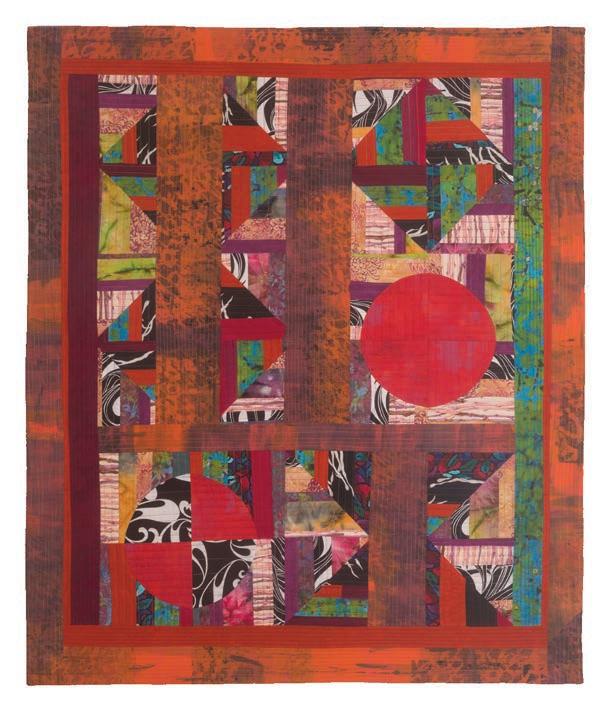

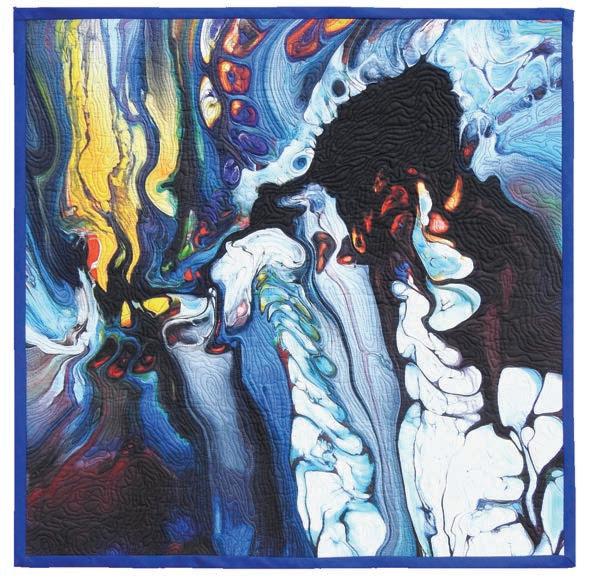
22 • SAQA Journal • 2022 | No. 4
ARTIST
JURIED
SHOWCASE
Joanne Alberda Evening Light 71 x 27 inches (180 x 69 cm) | 2021 Marian Zielinski Blue Lava 35 x 36 inches (89 x 91 cm) | 2021 Amelia Leigh And They Tried To Divide Us 45 x 38 inches (114 x 97 cm) | 2020
Photo by Katie Vandyck


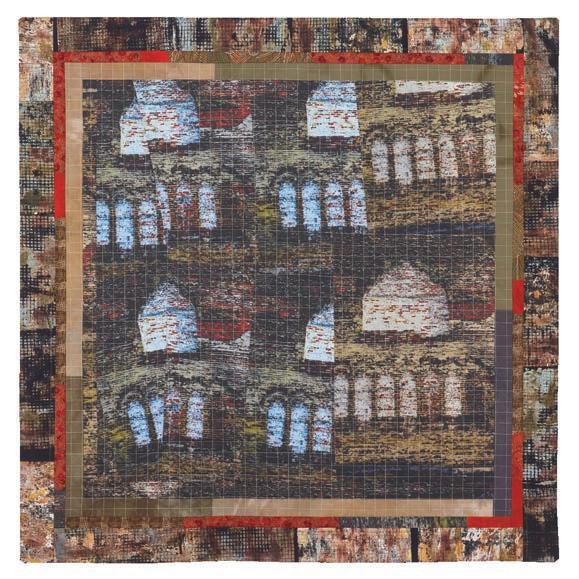
SAQA Journal • 2022 | No. 4 • 23
The
of Heat—Diptych 50 x 90 inches (127 x 229 cm) | 2021
Vicki Conley
Color
Photo by Doug Conley
37
37 inches (94 x 94 cm) | 2020
Susan Webb Lee Church Street Alley, Asheville
x
No. 16 55 x 55 inches (140 x 140 cm) | 2021
Judy Kirpich
Indigo Composition
Photo by Mark Gulesian
Jan Soules named latest SAQA Award recipient
Jan Soules was selected as the 2022 SAQA Award win ner for work juried into Quilt Visions 2022 at Visions Museum of Textile Art in San Diego, California.
Her piece, Finding Neverland #5: Blue Lagoons , was selected by the exhibition’s jurors based on the award’s criteria that a winning piece be compelling, dynamic, and progressive. The award recipient receives a $500 prize. The SAQA award is presented to one artist at four prestigious tex tile exhibitions: Quilt National , Art Quilt Elements , Quilt Visions , and Interpretations .
The three jurors for Quilt Visions were enthu siastic about their selection of this energetic,

improvisational piece. Lisa Walton said that she was drawn to the vibrancy and movement in the work. Sheila Frampton Cooper said, “The move ment and striking palette takes me on a wild ride! I personally love fantasy, and when I gaze upon this piece, I feel as if I'm descending into another world—a world in which a great deal of adventure awaits me.” Petra Fallaux said that the art quilt stood out for “being a highly complex piece, yet it manages to have a distinct clarity of composition.”
Quilt Visions 2022 continues through December 31, 2022. ■
Jan Soules
Finding Neverland #5: Blue Lagoons
41 x 43 inches (104 x 109 cm) | 2021
24 • SAQA Journal • 2022 | No. 4
Hear our voice
SAQA shares our art through exhibitions, publications, and outreach. We succeed because of your support. Our recent accomplishments include:
• Textile Talks, one of our outreach programs, reached two major milestones: 18,000 people have now registered to attend Textile Talks, and there have been nearly 200,000 views on YouTube!
• Four of SAQA’s catalogs jointly won the Best of Category award for catalogs with four or more colors at the 2022 Print Excellence Awards.
• In 2023, SAQA will issue at least five calls for entry for global exhibitions. Each exhibition will travel for three years to multiple venues around the world. Exhibition art is showcased on SAQA’s website, in a print catalog, and via Textile Talks, social channels, and artist interviews. The budget for SAQA’s exhibition program is approximately $225,000; only 20 percent is earned through jury fees, catalog sales, artwork sales, and exhibition rental fees.

Your gift to SAQA supports all of our achievements. Help us continue to be heard with your donation today.

SAQA Journal • 2022 | No. 4 • 25
WWW.SAQA.COM/DONATE
Chugoach Clouds (left) and Mesa Clouds (right) by Cat Larrea
NFTs offer new avenues for artists
by Alexander Taylor
NFT is a term that has seen a meteoric rise in popularity through out mainstream media in recent months. Even Starbucks is hopping on the bandwagon with its upcom ing Starbucks Odyssey program that will give NFTs—branded by the coffee giant as journey stamps—to customers that engage with it.
More importantly, some artists are becoming fabulously wealthy from them. Christie’s, the famous auc tion house, surpassed $100 million in sales from NFTs a year ago—$69 million of that being from a single sale in March 2021, according to an article by The Verge. OpenSea, the largest NFT exchange, surpassed $20 billion in total sales volume in February of this year, as reported by Bitcoin.com in October 2022.
So, you might ask yourself: “What are these NFTs, anyway? And how do I get in on all that money?”
What is an NFT?
In short, an NFT is a non-fungible token that proves ownership of a digital asset. The “non-fungible” part means that it’s unique and not inter changeable. The “token” part means that it represents something else. An NFT and its current owner is registered on the “blockchain”—the ledger of all transactions for a cryptocurrency—to provide proof of ownership.

I know, that’s a lot of funny words. So, let’s break it down a bit further:
Commodity assets like gold are fungible . We recognize all gold of a certain purity, such as 24K, as being the same value. Unless something has been done with that gold, like being turned into a piece of jewelry, all 24K gold of equivalent weight is effectively interchangeable. Your ounce of 24K gold is worth the same as my ounce of 24K gold.
Your house, on the other hand, is nonfungible . There is no other house I could give you in exchange for your house that the market would agree is pre cisely equivalent in value. Even if I had an exact replica of your house to sell you, that house wouldn’t be physically located in the same exact place as yours. Since part of the value of a house is where it’s located, that makes your house unique.
How do we know that house is yours? You have a token that repre sents your ownership of it: the title. You don’t need to be physically present in your house or write your
name on it or anything for us to know you own it. Your token, the title, proves that.
Or, at least, it should. But, what if someone forges a copy of it? How do we know your title is the real one? In real estate, a copy of your property’s deed is typically kept by the county or municipal clerk’s office and we can check to make sure the two match. For an NFT, its ownership and transaction record is stored on the blockchain of a
cryptocurrency (typically Ethereum) in a process called “minting.” This will create a cryptographically prov able record that whoever possesses that NFT is the owner of that NFT. Anyone can verify this at any time by asking a computer to do some complicated math.
Why do NFTs exist?
Great works of art can be worth millions and sometimes hundreds of millions of dollars. This is, in large part, because of scarcity: There
26 • SAQA Journal • 2022 | No. 4
” Great works of digital art have a problem. They aren’t scarce at all.
“
is only one Mona Lisa . There are only so many works of art created by Picasso or Rembrandt. Sure, you could buy a print or a gicleé, but there is only one original.
Great works of digital art have a problem. They aren’t scarce at all. They can be quickly and perfectly duplicated by a simple copy and paste, and this can be done an infinite number of times. They’re fungible . Additionally, you’ll never know whether you have the original file or not because there’s no way to store or prove provenance, as you or an organization would for a famous painting.
This is where NFTs come in. Since each token has a unique crypto graphic signature and is recorded in a publicly accessible ledger of trans actions (the blockchain), it provides both scarcity and provenance. There may be countless copies of the file containing a piece of digital art work, but there are a limited num ber of copies (typically just one) of the NFT that points to or contains that digital artwork.
“Minting” an NFT
The first step for minting an NFT is easy: Make sure you have the image (or other data you’re putting into the NFT) on hand. Typically, this is an image file, but technically this can be just about anything. We’ll look at some different ideas in a moment.
Once you have your file(s) on hand, you’ll want to choose a block chain to host the NFT. There are a very, very large number of crypto currencies out there (10,000+), so this part can be overwhelming. Here are a few recommendations:
• Ethereum is the most popular, but can be expensive.
• Solana is cheaper and has low transaction fees, but is less popular.
• Flow is an alternative that has been used heavily by sports fran chises like the NBA.
the largest market possible. But, an exchange might be more useful than a marketplace if you’ll be negotiat ing your NFT sales in-person, say, as an add-on to buying your physi cal quilt. Regardless of what you choose, you’ll want to follow that platform’s user documentation to
• Others exist, such as Polygon, that are far less popular but have other benefits, including no fees.
In order to actually store the NFT you create, you’ll need a “wallet” to hold the token. The most popular choices for this are Coinbase (www. coinbase.com) or MetaMask (www. metamask.io), both of which are free to set up. They both support Ethereum, Solana, and Polygon, among other currencies.
Once you have a wallet, you’ll want to choose an NFT marketplace. OpenSea (www.opensea.io) is the most popular and supports both Ethereum and Solana, as of July 2022. Solanart (www.solanart.io) is a popular competitor that uses Solana directly. And, if you’re not interested in selling your NFTs on a marketplace, many other cryptocur rency exchanges like Binance (www. binance.us) support NFTs as well.
If you’re new to NFTs and just getting your feet wet, I would recommend OpenSea. It’s got a user-friendly interface and offers
create an account, add a wallet, and start adding NFTs (OpenSea calls this process “creating a collection”).
Selling an NFT
Selling an NFT you own is as easy as listing it for sale on the market place you chose or transferring the token to someone else through an exchange. If you’re selling on a marketplace, this should be mostly automated once you’ve created a listing. If you’re selling to someone through an exchange, you’ll need the buyer’s wallet “address”—a long string of numbers and letters that uniquely identifies their wal let, kind of like a credit card num ber. The specifics here will differ depending on what marketplace, exchange, and/or cryptocurrency you’re using, so be sure to check the documentation.
There are a couple of other things that should be clarified about NFT sales as well. The first is that if you sell an NFT of your work, that’s all you have sold. The sale of your NFT
SAQA Journal • 2022 | No. 4 • 27
”
The sale of your NFT does not confer ownership of any physical items (like your quilt).
“
does not confer ownership of any physical items (like your quilt). It also doesn’t confer ownership of copyright. You retain copyright over both your quilt and any images of it. And, even if you sell your quilt and an NFT of it together, those two items don’t have to remain together. The purchaser of the quilt could keep it and sell the NFT to someone else later.
The second is that creating NFTs isn’t completely free, although things have improved significantly over the last few years with regards to cost. Traditionally, in order to create the NFT, you would need to register it on the blockchain which would require “gas”, a transaction fee. OpenSea’s new “collections” feature (mentioned earlier), among other advancements, have largely removed this cost.
Selling an NFT, however, still generally costs money. Again, this depends entirely on the market place, exchange, and/or cryptocur rency you’re using, but typically transaction fees for a sale will be around 1-3 percent of that sale, somewhat similar to a credit card processing fee. Keep that in mind as you start to sell your NFTs.
Should I make NFTs?
This is a tough question to answer directly. The easy answer is “no”: NFTs are intended for digital assets, not physical ones like quilts. Your art quilt is already a non-fungible asset, so you don’t need an NFT to create value.
That being said, NFTs are the hot new thing right now, and everyone is trying to find ways to cash in. That’s,
presumably, why you’re still reading this article! So, here are some ideas for ways you could still engage with the NFT market as a quilt artist:
1. Take a photo of your work and create an NFT for it. This is prob ably the most obvious and direct way of turning your quilt into digital art.
2. Do the above (possibly with a picture of the certificate of authenticity as well, if you provide one with your quilt), but offer it as an add-on (free or paid) to the sale of your physical quilt. There’s always the possi bility that offering an NFT with your quilt might entice a buyer that’s on the fence.
3. Instead of having a photo of just the work, maybe use a photo (or multiple photos) of your quilt on exhibit at shows as the NFT instead. It might be really cool for someone to purchase your quilt along with an NFT photo album of all the places it’s toured!
4. Experiment with services like Flipkick (www.flipkick.io). Flipkick uses Near-Field Com munication (NFC) tags that can be physically attached to (or sewn inside of) your artwork to tie an NFT to the physical item. You would make an NFT of the digital signature from the NFC tag, rather than an image, in this case. Anyone who scans the NFC tag from your quilt would be able to match its signature to the one from the NFT to verify that it’s authentic. (NFC is how the see “NFTs” on page 33
28 • SAQA Journal • 2022 | No. 4
Manage time in your art practice like a boss
by Clara Nartey
Time management is a term that you often hear bandied around corporations and big organizations as they strive for more efficiency and productivity. Creative people usually get the short end of the stick when it comes to discussions about time management. We’re often thought of as people who aren’t good at managing time, who don’t want to manage time, and who can’t be taught to manage time. Those labels aren’t true.

We live in an industrialized and highly technological world. Most work systems are built to cater to the realities of these environments. I’m sure you’ll agree with me that creative work is not as mechanical as the technologically advanced approaches to work that are preva lent today. That’s not to say that there isn’t creativity involved in technical work. There is. In fact, a lot of creativity goes into the prod ucts and services we enjoy every day. Look at the iPhone and its
ecosystem of products and services. You don’t need to look further than that to see creativity in action.
However, the creative work of an artist is quite different. Here, the process is more the heartbeat of the work as opposed to churning out a product solely for sale. Conse quently, you can’t paint both types of creativity with the same broad brush.
In my previous life as a manage ment consultant, I was good at managing my time. It was a require ment of the job. Most people have to learn to do this well if you work in a high-pressure environment. But when I started working as an artist, I initially struggled to manage my time and to find the time I needed to do the creative things that I wanted to do.
In other fields, your credentials are made up of the quality and/ or number of courses, certifica tions, and training programs you take. Being an artist isn’t like that.
Mastering your craft as an artist is dependent on how much time you devote to consistent practicing. Because creative people need to put in the hours in order to master a craft, time management is of para mount importance to them.
Yet, artists and creative people seem to fall behind when it comes to managing time. Artists don’t have the same structures in place that help people in other profes sions manage their time well. As artists, we can work for however long we want and at whatever time we choose. In many ways, it’s that freedom that draws many creative spirits into creative journeys. This lack of structure and accountability to authority is also what gets many of us in trouble.
What can we do to properly man age our time? After all, it’s abun dantly clear that we need time to grow, hone our skills, and master our craft. What do we do? Five key steps help me stay on task. They are:
SAQA Journal • 2022 | No. 4 • 29
• Know your why
• Take inventory/track your time
• Commit to small steps
• Put a structure/routine in place
• Find an accountability partner
Your why
Let’s start with the reason you’re in this field of work. We all have dif ferent reasons for why we choose to create art. Some of us do it for fun. Some do it to fulfill a long-lasting desire to reach the creative potential we know we have. Others do it to build a sustainable career.
Our ultimate goals are just as varied. For example, if your goal is to have fun, you may be perfectly happy with completing four pieces of work a year, gifting them to your loved ones, and seeing the joy your gifts bring to them. On the other hand, if your goal is to build a career, then you are interested in achieving different milestones. What’s important is this: your why motivates you when things get tough. Secondly, what you want out of your creative adventure deter mines how much time to commit to it. So, pull out your journal and reflect on your expectations.
Time tracking
We have a fixed amount of time in a day. So, how do some people get a lot done while others don’t? The only way to know what’s cutting into time for your creative endeav ors is to take an inventory of your time. It’s very easy to think we don’t have a lot of time. However, when you start paying attention, you’ll be surprised at how much time you invest into things you don’t consider important. Where is
your time being used daily, weekly, monthly? Are you putting your time into what really matters to you?
It’s hard to answer these questions unless you track your time. Which activities are you proud of investing time in? Which ones are taking up time which you could use for some thing better? Tracking your time is the first step in finding more time for creative endeavors.
Small steps
Now that you’ve located time on your calendar for creative work, make a commitment. You don’t need to start with something big, just a few doable action items. Every art ist needs an art practice. So all you have to do at this point is to make a commitment to use your newfound time to create art. Make sure other activities do not encroach on this time—guard your creative time.
You’re the boss
Now it’s time to use your boss pow ers. You’re the boss of your creative adventure. You’re in charge, you make the rules. So make some rules regarding structure and routine. We need structure. It helps us stay focused whether we’re working on a job outside of our home or in charge of our creative practices. Design a studio practice that works for you. You’ve found the time in your schedule. You’ve made a commitment. Now, set it up so that it’s a routine. For example,
your rule can be thirty minutes of studio practice every day at 10 a.m. Make your rule something you can stick to. Remember, small steps first. At this point, what you want is consistent achievement. Over time, when you’re used to this new rou tine, you can increase the time to make room for more work. One way to ensure you’re using your creative time wisely is to work on one thing at a time. Multitasking breaks your concentration and you don’t get much done.
Ensure accountability
If you were working for an orga nization, you would be account able to someone. Accountability helps us review our progress and stay on track. Being your own boss doesn’t mean you can’t have all the same benefits of accountabil ity. You can get an accountability partner who will help you put in the work required to achieve your goals. Look for an accountability partner that you trust to tell you the truth—someone who believes in you and who will push you toward you potential. Your partner can be a family member, a friend, or another artist. Meet with that person on a regular basis.
Managing your time as an artist is very possible. You have a lot of choices in how you shape your art practice. You shouldn’t feel that
30 • SAQA Journal • 2022 | No. 4
see “Time Management” on page 36
What’s important is this: your why motivates you when things get tough. “ ”




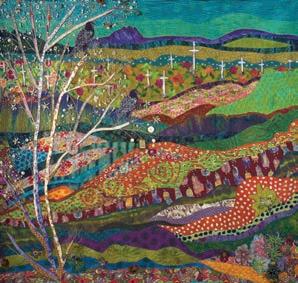


SAQA Journal • 2022 | No. 4 • 31 An Annual Art Quilting Conference ~ April 2nd - 8th, 2023 ALEGRE RETREAT 2023 Gateway Canyons Presents Featuring Renowned Fiber Artists: Jane Dunnewold | Paula Kovarik | Terrie Hancock Mangat | Katie Pasquini Masopust To Register: www.alegreretreat.com | 43200 Hwy 141 | Gateway, CO 81522 More Information: 505-470-5202 | www.gatewaycanyons.com
Retreat is an escape from everyday life for art quilters to come together to learn and share their expertise. Join us at Gateway
to study with one teacher for five days and hear lectures from all. The conference will feature Jane Dunnewold’s
“Color Wheel Dyeing and Overdyeing”;
“At Play in the
Move Mountains”; Katie
“Grid Work”.
Alegre
Canyons
class,
Paula Kovarik’s class,
Garden of Stitch”; Terrie Hancock Mangat’s class, “We
Pasquini Masopust’s class,
Patti Pasteur
from page 21


Maine were fairly isolated. Working on creative projects kept me sane. Now that I’m living in North Caro lina, I’m closer to everything. I am able to do art shows without having to travel far. New Bern [North Caro lina] has a thriving art community. I was so excited and honored that my quilt, There Was One Left (page 20) , was selected and published in San dra Sider’s book, Quarantine Quilts: Creativity in the Midst of Chaos . That particular quilt was the result of a photograph I took of empty shelves in a well-known store. I went home and started to think about how I was going to incorporate the picture into a quilt. I took a separate photo of myself holding a package of toilet paper and layered it with the empty shelf photo. I fussed a bit with the background and printed the image on nine separate cotton inkjet sheets and pieced them together—I did this before I discovered Spoon flower! I collaged the figure with bits and pieces of fabric and did a lot of machine and free-motion stitching on the background and figure.
The future holds promise of even more activity. “I plan on entering major exhibitions and continuing to explore and develop more quilts that tell a story. Plans for taking workshops in serigraphy are on my wish list. I also enjoy doing the Quilting Arts Magazine ’s Reader Chal lenge, because sometimes the proj ects challenge me to think ‘outside the box’. Sometimes the submission will be accepted and sometimes not; regardless, I’m have fun doing what I do in my art quilt journey.” ■

32 • SAQA Journal • 2022 | No. 4 SyncopationNo.1, detail, Judith Quinn Garnett www.vmota.org For more information, visit interpretations2023.artcall.org January 1 to February 10, 2023 (CFE Closes 12 noon PST) Jurors Susan Taber Avila, Dolores Miller, and Jason Pollen Cash Awards Call for Entries Interpretations 2023
Diane Howell is the SAQA Journal editor; she resides in the Phoenix Metro.
from
fancy new “tap-to-pay” contact less credit cards work, if you’ve seen those.)



Ultimately, it’s up to you to decide if the opportunity cost is worth it. Getting started with NFTs can be daunting and requires a bit of setup. If you’re comfortable with your quilts and want to continue put ting your time and effort into what you’ve been doing, you shouldn’t feel bad about missing out on the latest fad. But, if you’re looking for an extra revenue stream from your work, it’s possible that NFTs could be a worthwhile avenue to pursue. ■
Alexander Taylor is a Florida-based software engineer. He works for Vector 35, which creates tools for use in the computer security industry.
SAQA Journal • 2022 | No. 4 • 33 CALL FOR ENTRY: JANUARY 1-31, 2022 CALL FOR ENTRY: APRIL 1-30, 2023 V IRT U AL G A LLER IES GLOBAL EXHIBITIONS CALL FOR ENTRY: JANUARY 1-31, 2023 CALL FOR ENTRY: JUNE 1-30, 2023 CALL FOR ENTRY: OCTOBER 1-31, 2023 CALL FOR ENTRY: JULY 1-30, 2023 CALLS FOR ENTRY For complete details on all exhibitions, visit www.saqa.com/calls Innovation in Fiber, Art, and Design Surface Design Association www.surfacedesign.org Alisa Banks, half, 2014 Membership Includes: • Exhibition opportunities • Access to grants & awards • Connection to regional groups • Virtual events, panels and talks • Complete digital journal archive Join Our Community! NFTs
page
28
Juror Dr. Carolyn Mazloomi Entries accepted: January 15 - May 15, 2023






Artists are invited to interpret the theme “No Boundaries” in an original piece of fiber-based artwork. Artwork will be considered in any media but MUST contain a minimum of 25% fiber component or fiber techniques.

Photo Studio
from page 17 stable support for your camera and let you correctly position the camera so all quilt edges are square. If you’re photographing your quilt from above, you may need an extra extension arm that will allow your camera to be positioned over your quilt without the tripod itself being in the way.
If you’re using a permanent ceiling-mounted setup, consider a ceiling camera mount instead of a tripod (See Figure 4). The ceiling camera mount attaches to the ceiling and allows the camera to be sus pended from above. This is how my camera is mounted in the center of my ceiling-hung shop lights.
Last but not least, use a remote trigger when possible. A remote trig ger (a remote control for a cellphone or a smartphone app for a DSLR) will allow you to take a photo without having to touch the camera. This hands-off approach will prevent the camera from jostling and ensure your photo is in focus.
Why do good photos matter?
A photo of your quilt is an exten sion of the original art. In a way, it’s an ambassador for your work, and thanks to the internet, more people are likely to see a photo of your work than the original quilt. You owe it to yourself and your work to present your art at its best, and that means taking high-quality, profes sional photos.
For more information about pho tographing with a DSLR, including what specific settings to use, read my blog about photography basics at the QR code on page 17.
Kestrel Michaud is a SAQA mem ber who resides in West Melbourne, Florida. You can view her work at www.kestrelmichaud.com.
34 • SAQA Journal • 2022 | No. 4 CALL FOR ENTRIES Find more info at: vaquiltmuseum.org 301 S. Main St. • Harrisonburg, VA 22801 | (540) 433-3818 2nd Biennial Juried Exhibit: “No
Boundaries”
Visit our website for dates and locations throughout the USA Sacred Threads Seeking New Leadership Interested? Visit the website to learn more. sacredthreadsquilts.com SPONSORED BY:
2022 Traveling Exhibit
SPIRITUALITY • PEACE • HEALING • GRIEF • INSPIRATION • JOY
Shared Foundation by Marisa Marquez
■
In Memoriam
Rhonda Baldwin
Rhonda Jo Baldwin, 65, of Grand Island, Nebraska, passed away on Sept. 4, 2022, in Meeteetse, Wyoming.
Rhonda was born on July 13, 1957, in Omaha, Nebraska, and grew up in the Grand Island area, graduating from Grand Island Senior High in 1975. She continued her education at the University of Nebraska-Lincoln and then at University of Nebraska Omaha, where she earned a bachelor’s degree in interior design in 1980. On March 28, 1981, Rhonda married Ron Baldwin. They had two children, Ali and Gable.
Her talents were numerous. She founded a children's educational toy store, was a dance teacher for more than 20 years, and co-owned a dancewear boutique, all while being the business administrator at JIL Asphalt Paving Co., Inc., in Grand Island. Her creative interests were wide-ranging,
but her greatest passion was fiber art. She was a long-standing member of SAQA, and was the former co-representative for the Nebraska region. She was the current co-coordinator of the Nebraska Regional Exhibition Committee and the co-chair of SAQA’s Special Event Committee.
venues around the world for decades. Her book, Curves in Motion , was a primer for how to piece swirling curves as well as a guide to fabric selection, understanding color and value, and ensuring that each quilt was meticulously finished.
Her own quilts displayed superior artistry and craftsmanship, and many are in prestigious collections, including the White House Collection of American Crafts, the Shelburne Museum, and the National Quilt Museum. One of her quilts was used in the 2018 remake of the film A Wrinkle in Time . Judy’s body of work was featured at the Shelburne Museum.



Judy B. Dales

Judy Dales passed away on away on October 9, 2022, from cancer at her home in Greensboro, Vermont.
She introduced a new approach to curved piecing, and taught this technique at
She was a master teacher who perfected the art of critique in a positive and often humorous way, and she mentored her students and friends almost to the end. To remember Judy’s work, visit www.judydales.com.
FUTURE OF TRADITION
SAQA Journal • 2022 | No. 4 • 35 SAQA8 Comments Seen by 13 LikeComment Connect today! Join https://www.facebook.com/groups/mySAQA Join SAQA - Members Only on Facebook • Daily contact with SAQA members around the world • Inspiration • Special invitations • Works in progress • Camaraderie Be part of SAQA - Members Only to enjoy 1523 N 33RD ST, LINCOLN, NE • 402.472.6549 WWW.INTERNATIONALQUILTMUSEUM.ORG Tuesday - Saturday 10AM to 4PM Home to the world’s largest collection of publicly owned quilts, representing more than 50 countries and dating from the 1600s to today.
time management takes away your creative freedom. You’ll always be the boss of your creative adventure. All you need to do is learn how to put your creative freedom to use for yourself.
Regardless of how much time you have on your hands, whether you’re retired or creating art as a full-time career, you will have to actively work at using your time wisely in order to do the things that you love. Many interesting opportunities await you, and you want to be able to take advantage of as many as possible. ■
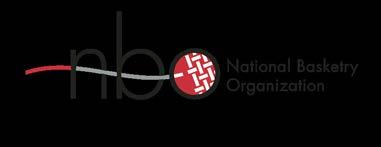
Clara Nartey is a SAQA member who resides in West Haven, Connecticut. She is an artist who creates video les sons to teach artists about professional development. Learn more about her at www.claranartey.com.

36 • SAQA Journal • 2022 | No. 4
BE INSPIRED GET CREATIVE EXPLORE TECHNIQUES + MATERIALS Join the National Basketry Organization! nationalbasketry.org
TRESSA SULARZ
2023 Seminar: Material Matters JANUARY 23 - MARCH 17, 2023 Register for this free, eight-week program to explore the materials we use—from the common to futuristic substances just being invented . Enjoy video conversations, articles, and optional activities as you dive into the deep well of resources that accompany each weekly unit . Developed by the SAQA Education Committee just for SAQA members . For details, visit www.saqa.com/seminar . REGISTRATION OPENS IN JANUARY
Time Management from page 30







SAQA Journal • 2022 | No. 4 • 37
Annette McFarlane La Strada
Pixeladies
Rainbow Trout 2
Doreen Prakshot Lizzie
Deb Plestid Victory
Beth and Trevor Reid Forever Falling #2
Gwyned Trefethen Lola on the Stairs
To our donors & bidders, we extend a grateful thank you. Your generosity raised more than $78,000 to support all of SAQA’s many programs. We look forward to 2023! www.saqa.com/auction 2022 SAQA Benefit Auction
Pauline Salzman Little Red Riding Hood
Drama
24 x 60.5 inches (61 x 154 cm) | 2021
by N.K. Quan
The emotional high points of sport ing events inspired Ann Houle to create Athletes, her series that captures the drama of competitive sports.
“About twelve years ago, I noticed my emotional reaction to moments in sports felt gripping. It’s the moment when you catch your breath at the amazing physical or psychological feat that the athlete is performing,” she says.
Drawing on her training as an actor and her many years in theater, Houle finds that those compelling moments are analogous to the climax in a drama, the point when the audience leans forward and anticipates the next revela tion. “One of my goals was to capture that fleeting moment in my quilts.”
The series, which spans several years, features art quilts that explore creative challenges. An early piece, 100-YardDash, asks the question, “Can I recreate the complex moment of sudden explo
sive movement?” Houle chose the start of a sprinting competition to explore how using fewer details and a palette of muted colors combine to create a blurred effect and a sense of confusion.
Her early work was influenced by the idea of witnessing sports through a small television set. The quilts were physically small, and the quilting lines simulated the lines of a cathode ray tube television.
Over time, her creative ideas evolved. With Puck Drop (on the front cover), she explores the moment of intense anticipation before the competitors burst into action. The figures are created in vivid colors so that each one is seen with equal intensity. In Fencers, which recreates an attacking lunge, the figures are caught mid-movement. Rather than capturing a blur, the action is stopped, the beauty of an instant preserved in perfect focus. In both of these quilts,

limited action and sparse environments allow the athletes to be in high relief, Houle explains.
In Strike One, her latest addition to the series, she plays with the background to take her subjects out of realistic settings and creates a backdrop that enhances the athletic movements. The focus is on the swing of the bat, the wave of the umpire’s hand, and the arc of the ball.
“I’m really about story and drama, and how that is expressed physically. Sport offers a really clear, lean story in physical terms, so viewers can quickly get invested in the image on the quilt, because we all know the ‘story’ of a competition.”
Houle has loved fabric arts since the young age of nine, when she spent hours standing in front of an embroi dery floss display at the five-and-dime store. By the 1990s, she took an interest in quilting and learned its craftsmanship
38 • SAQA Journal • 2022 | No. 4
Fencers
INSPIRED BY
Photos by David Reese
through making traditional quilts. The next step was to create art quilts.
“I am fortunate to have lived in the Oakland East Bay when I started learn ing the basics. There was, and still is, a vibrant art quilt community there.”
Houle is now taking her Athletes series in a different direction. One artistic area she will explore is how the quilting lines can enhance the sense of movement. She will abandon the simple horizontal quilting for a different approach.


She is currently working on several quilts that were inspired by a friend’s black-and-white photos of her father, who was a bodybuilder and gymnast in the 1940s and 1950s. These quilts may use repeated images or even threedimensional figures. ■
N.K. Quan is a Phoenix, Arizona-based writer and editor.
100 Yard Dash 23 x 30.5 inches (58 x 77 cm) | 2017 Strike One
SAQA Journal • 2022 | No. 4 • 39
24 x 34 inches (61 x 86 cm) | 2022








quarterlyartquilt $14.99US/$17.99CAN UCBerkeleyArtMuseum ArtquiltsinHawaii CarylBryerFallert-Gentry art quilts113 StudioArtQuiltAssociates quarterlyartquilt $14.99US/$17.99CAN Fabric of a Nation Sales of Art Quilts Fur,Fangs,Feathers&Fins art quilts115 StudioArtQuiltAssociates IssueNo.25 quarterlyartquilt $14.99US/$17.99CAN Quilt National ’21 WeAretheStory Documentingyour collection art quilts120 StudioArtQuiltAssociates www.saqa.com/aqq Art Quilt Quarterly SAQA’s quarterly publication is designed for collectors, arts professionals, and admirers of art quilts everywhere! The magazine features artist interviews, galleries of art quilts from SAQA’s traveling exhibitions, and professional advice on how to care for your collection. Now available in digital format! SAQA members receive $5 discount off print edition Subscribe or renew today–rates increase in 2023 artquilt $14.99US/$17.99CAN TerryHancockMangat ArtistsCulinaryquiltsinCatalonia to Watch Tennessee State Museum art quilts117 StudioArtQuiltAssociates artquilt $14.99US/$17.99CAN Chicago’sArtInstituteArtists to Watch DARNstudio art quilts99 StudioArtQuiltAssociates artquilt $14.99US/$17.99CAN Notes from a gallerist Lucille Packard Children’s Hospital Women’s Voices, Women’s Votes SAQA’s Ebb and Flow art quilts128 StudioArtQuiltAssociates IssueNo.22 quarterlyartquilt $14.99US $17.99CAN National Museum of Australia Nancy Erickson’s wild world The Habitat exhibition Dealingwithsmokedamage art quilts122 StudioArtQuiltAssociates





































































































